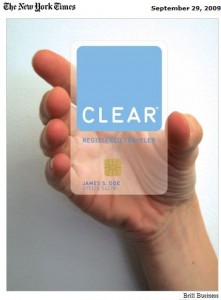 OK, I will admit it on this one, there may be a very simple answer on this that I am just not seeing. So let me know if that’s the case.
OK, I will admit it on this one, there may be a very simple answer on this that I am just not seeing. So let me know if that’s the case.
This morning I read an article in The New York Times by Brad Stone ‘Clear’ Security service May Return to Airports. I did some research on the story (though I will admit it was probably even less research that Dan Rather did on his George Bush story a couple of years ago – that was also in the paper today) and I couldn’t get a straight explanation about what this “Clear” service with its “Verified Identity Pass” actually offers passengers or airports. Evidently it helps airline passengers spend a lot less time in security lines at the airport for a fee of around $200 per year.
As I read through this article that talked about the fact that “Clear” may come back online after running out of cash earlier in the year, I started to try to piece together exactly what is going on with airport security. What outcome is TSA (which stands for Transportation Security Administration – not “taking scissors away” as some joke) trying to accomplish? What may seem obvious to you is not obvious to me. Is the goal to test whether passengers are a threat the day of the flight, or is the goal slightly different from that?
In the book Rethink I examine the flight check in process and suggest that there are really three outcomes that need to be achieved at that stage of the process:
1) Confirm Reservation
2) Complete Survey
3) Document Checked Baggage (if applicable)
There are two basic points in breaking up those pieces, and they are that the airlines have figured out that it doesn’t matter who is doing the work (employee or passenger), where it happens (counter, kiosk, web), or what the technology is that’s used to accomplish those three outcomes, but more importantly for the airlines, instead of looking for airline industry best practices for this set of “whats” or outcomes, seeing that none of the three things necessarily has anything to do with the airline industry, the opportunity to look for best practices in other industries that do those three things really opens the door of possibilities for improvement (increasing the need to be specific and measured about why you would change it and how you define success).
OK, that’s check in. Now on to security. What is really going on there? Is it to test that each passenger does not pose a potential threat to the flight/airport today, or is it a broader test of whether this person is generally a threat? Stone’s article talks about Clear customers having to submit to fingerprinting and iris scanning, but that sounds more like identity testing and today whether people use their driver’s license or a passport, that’s the least invasive, fastest part of the current process. That’s the first thing I got confused about.
The implication is that Clear customers get to shoot to the front of the line like airline employees and first class (and mile plan elite) passengers. I understand the airline employees getting to cut the line, but I haven’t really understood why first class passengers get to cut the line. First class passengers are actually the highest risk of the bunch since they are in a closed off section right next to the pilot’s cabin. Mile plan people make more sense to me because they fly a lot and they are most familiar with the process so they are probably fast.
Assuming the Clear people still have to take their shoes off and use the quart size zip top bag with nothing over three ounces and go through the X-ray (please tell me if I am wrong about that), then the $200 annual fee is really just a line cutting tax and the iris/finger printing thing is really just superfluous? If the actual security testing of these people is less rigorous than the rest of us, then someone has decided that the goal of security is a test of who is a threat to the flight/airport in general and that there’s no need for more rigorous testing the day of the flight. That seems strange to me.
What am I missing on this?
-Ric
Its all about the money. There is a segment of the population willing to pay for (or expense to their business) the cost of the program so they can avoid the long lines and feel privileged.
It reminds me of the currently free High Occupancy Vehicle (HOV) lanes that are here in Atlanta. They are converting those to a toll lane. In this way if you are a single rider you can buy your way into the HOV lane. I guess they’ll need to rename the lane after the pay-for-use system is implemented. Any ideas what they should call it?